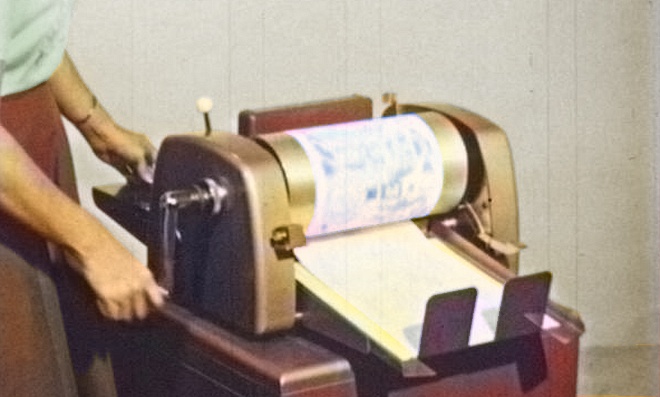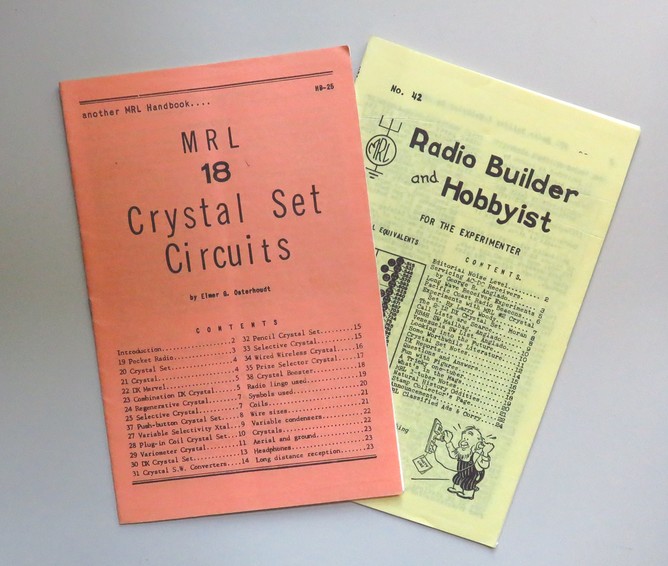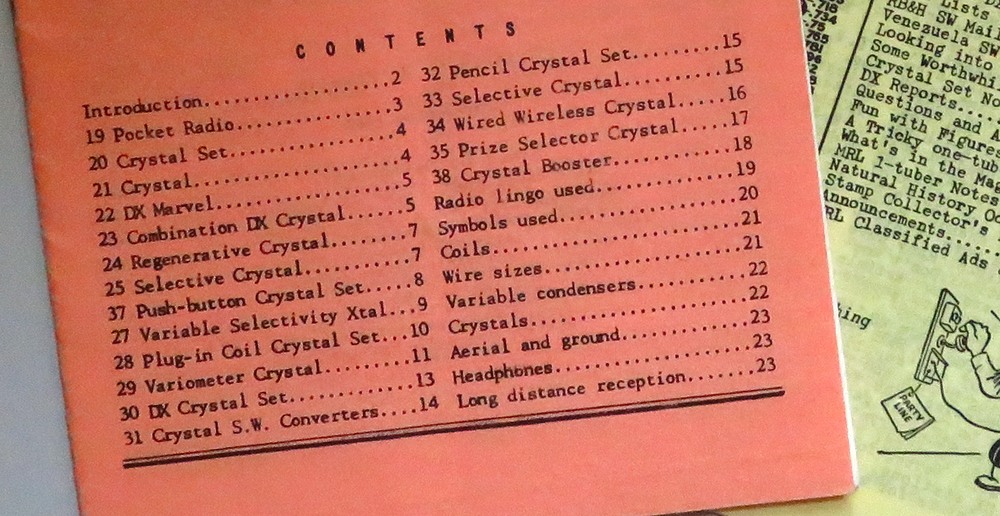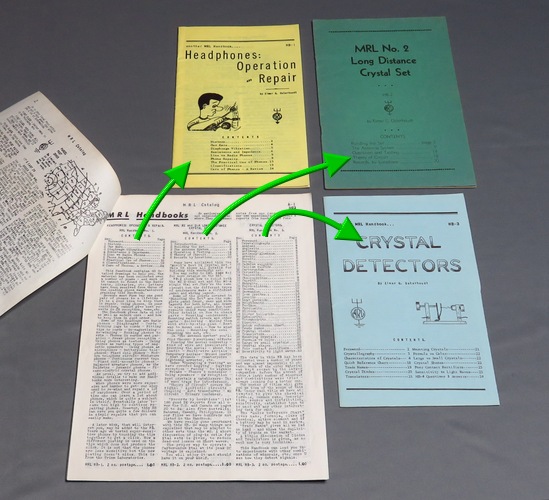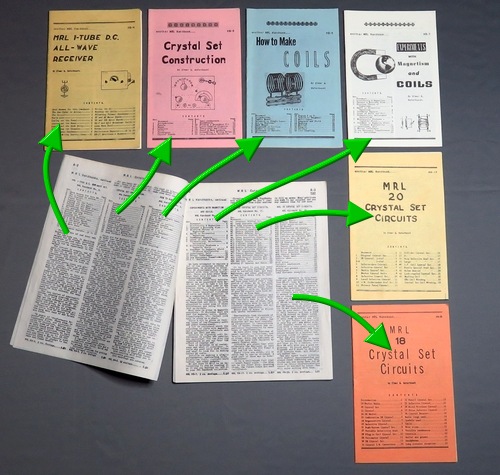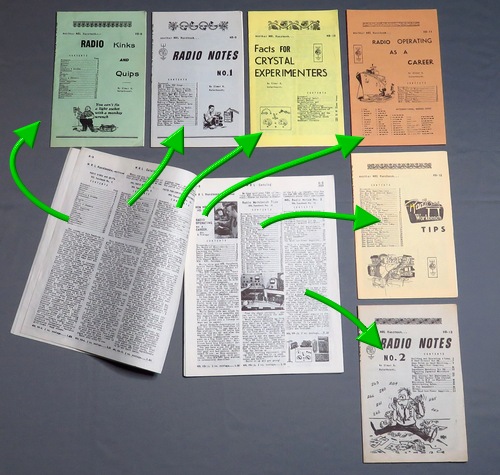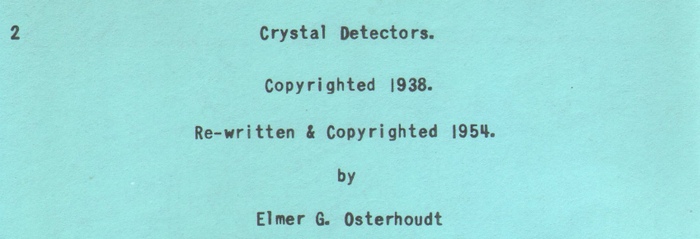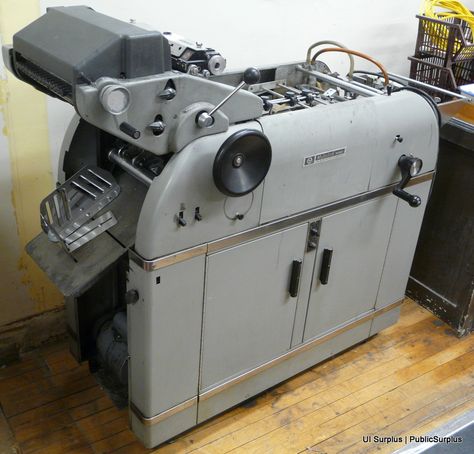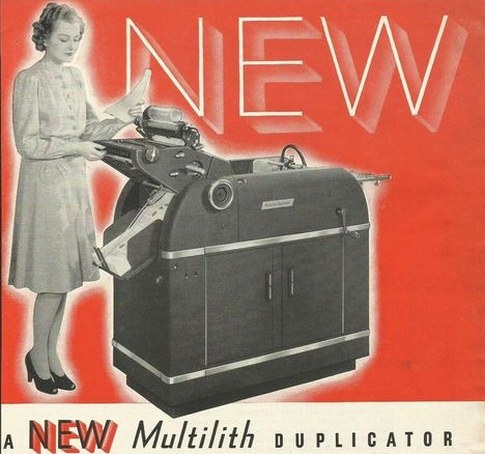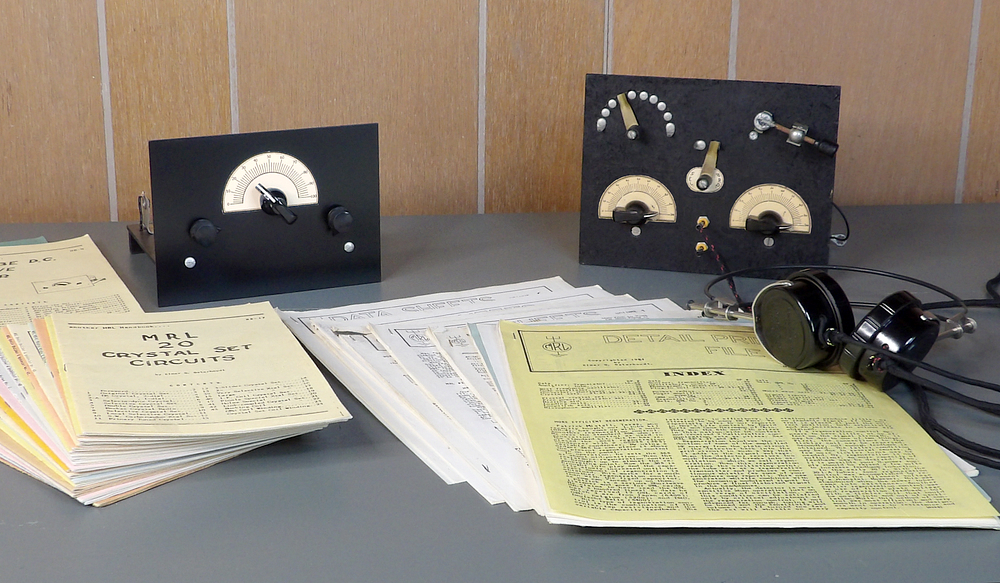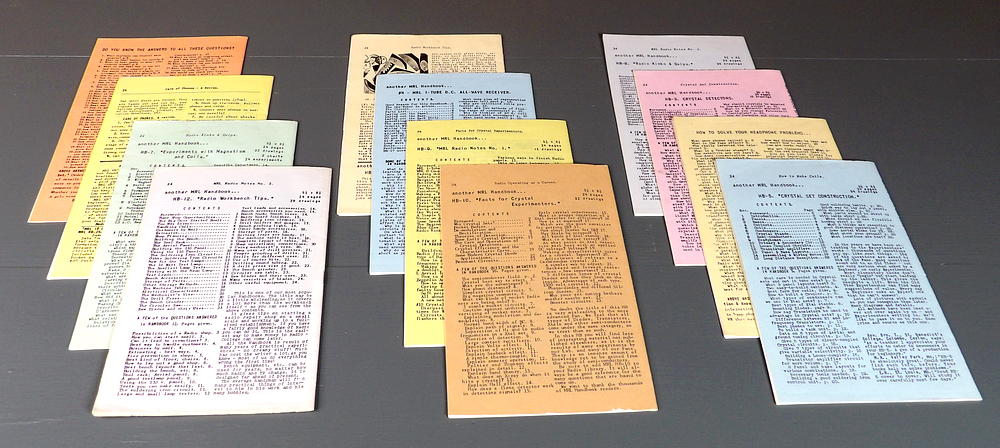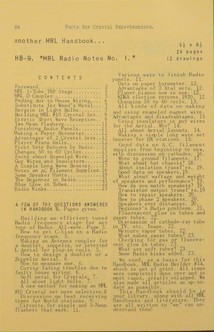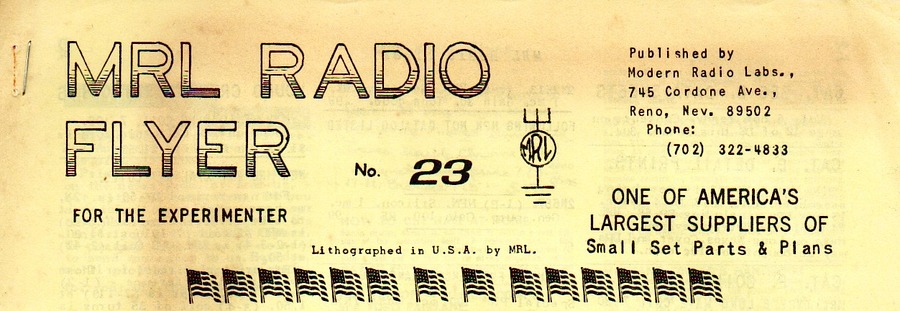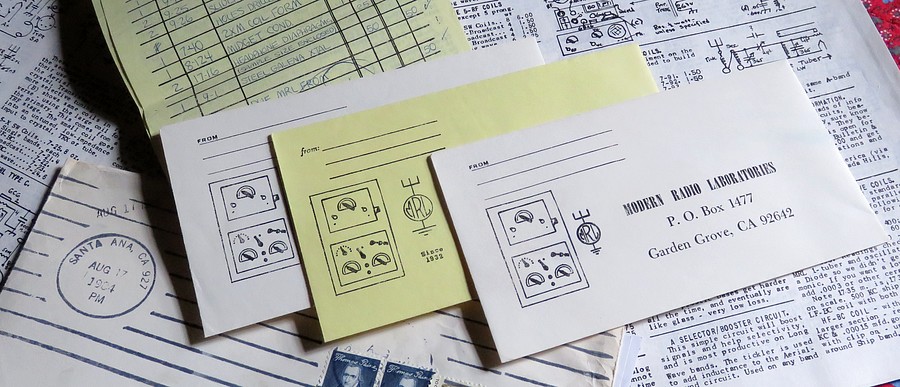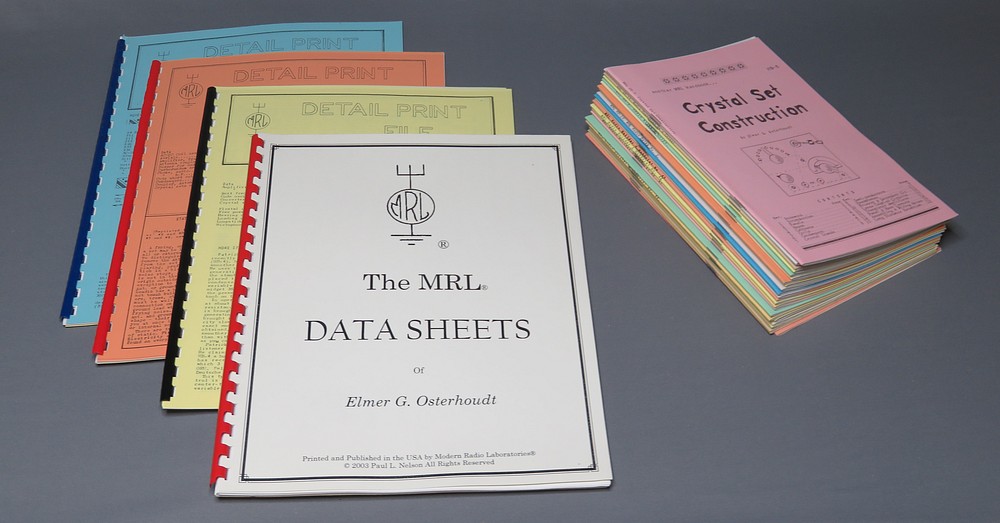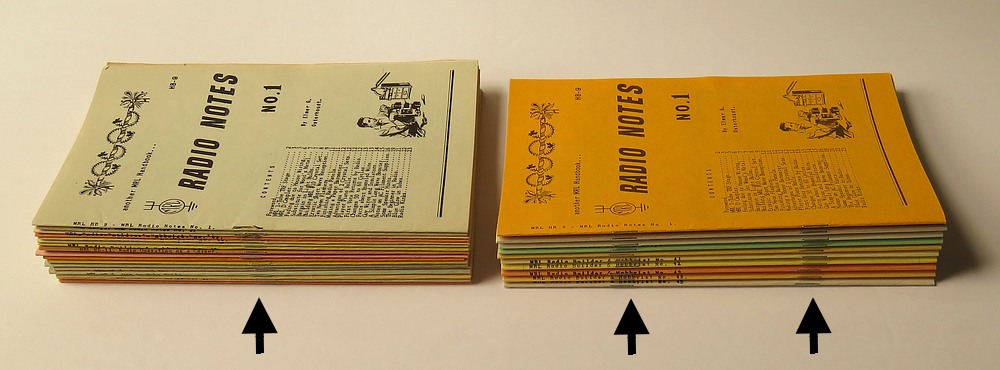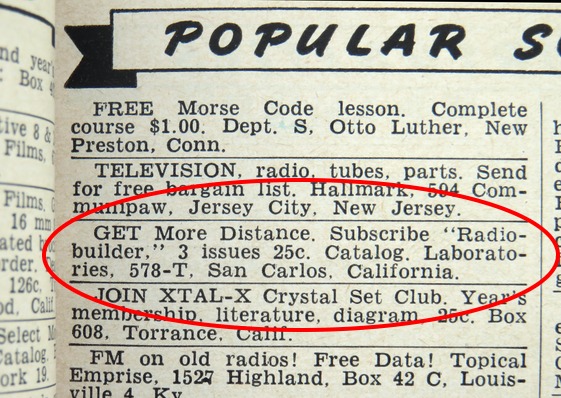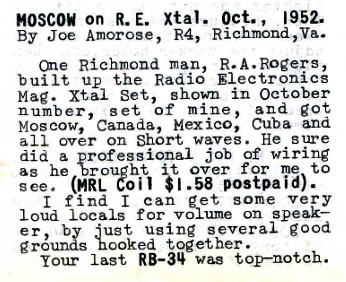|
|
|
|
|
|
MRL HANDBOOKS and LITERATURE. |
|
|
|
Since 1932 Modern
radio Laboratories have been foremost in recognizing
a definite and permanent class of Radio Fans devoted
to small set experimentation as a hobby. - Elmer
Osterhoudt
With the exception of "HB-2," all
MRL literature was self published and printed by
Elmer and Mabel Osterhoudt. |
|
|
|
|
Below is a list of Modern Radio Laboratories®
literature (may be incomplete.) |
Note: Most of the following
MRL publications can be found
here.
Handbooks, Data
Sheets and Detail Prints can also be found
here.
Other publications
can be found on Page 13
here.
MRL Handbooks:
HB-1 Headphones: Operations and Repair
©1948
HB-2 No. 2 and 2-A Long Distance Crystal Sets
©1945
HB-3 Crystal Detectors
©1938,
1954
HB-4 1-Tube D.C. All Wave Receiver
©1953
HB-5 Crystal Set Construction
©1956
HB-6 How to Make Coils
©1957
HB-7 Experiments with Magnetism and Coils
©1957
HB-8 Radio Kinks and Quips
©1958
HB-9 Radio Notes No. 1
©1959
HB-10 Facts for Crystal Experimenters
©1960
HB-11 Radio Operating as a Career
©1961
HB-12 Radio Workbench Tips
©1962
HB-13 Radio Notes No. 2
©1964
HB-17 MRL 20 Crystal Set Circuits
©1951
HB-25 MRL 18 Crystal Set Circuits
©1947
MRL BLUE PRINTS No known
copies. Unknown number of issues.
These early documents were designated "BP" or "Blue
Print." It was common in the 1930s for radio
magazines to publish blueprints, but in Elmer's
case they were blue prints (not blueprints) because they were mimeographed.
The mimeograph stencils for the MRL BP series wore
out, or in some cases, disintegrated.
| BP-1 |
Published in 1932. May
have described the MRL No. 1 crystal set.
(Not verified.) |
| |
|
| BP-2 |
"1 Tube D.C. All-Wave
Receiver". Written in 1940, six pages long.
Replaced with HB-4 in 1953. |
| |
|
| BP-3 |
"Crystal Detectors."
Copyright October 12, 1938. Replaced
with HB-3 in 1954. |
| |
|
|
BP-17 |
"18 DX Crystal Sets."
Published in 1934. The title of BP-17 was
gleaned from a 1936 advertisement. It
contained 18 circuits, according to "Radio
Notes No. 2," page 18. Some were vacuum tube
hookups, according to HB-17.
Replaced with HB-17 "MRL 20 Crystal Set
Circuits" per the "Forward" on the inside
front cover. |
| |
|
|
BP-25 |
"MRL 18 Crystal Set
Circuits." Published in the 1930s. Replaced
with HB-25, "MRL 18 Crystal Set Circuits" in 1947.
NOTE: The title of BP-25 is an educated
guess. See the advertisement
below. |
| |
|
|
BP-?? |
The May 1933 edition of
"Short Wave Craft" listed an ad for a
blueprint of a "DX 2-Tube SW circuit." |
| |
|
|
An ad in Short Wave Craft in 1934
stated there were 11 Blueprints.
One would think by the numbering system there were at least 25
by 1940. |
MRL OSCILLATOR No known
copies.
MRL OSCILLATOR #1 Published 1933.
MRL OSCILLATOR #2 Published 1934.
MRL OSCILLATOR #3 Published 1934.
MRL OSCILLATOR #4 Published 1934.
MRL OSCILLATOR #5 Published 1934.
MRL OSCILLATOR #6 Published 1934.
Magazine advertisements for the MRL OSCILLATOR ended
in 1934.
MRL Detail Print File No. 1
(copyright 1958) contains a reprint of an article
from MRL OSCILLATOR #6.
MRL Radio Builder & Hobbyist
(called "MRL Radio Builder" prior to 1953
and "Radiobuilder" in MRL ads)
The first advertisement for Radio Builder
is found in the February 1936 issue of
Short Wave Craft.
Radio Builder 1 to 24 - No
known copies. Number 3 was published in 1934.
Number 19 was published in 1941.
Radio Builder-25
Published in 1947.
Radio Builder-26, 30, 31 & 32 -
No known copies. All replaced
with HB-13, "Radio Notes No. 2"
in 1964.
Radio Builder-27 No
known copies
Radio Builder-28 No
known copies
Radio Builder-29 No
known copies
Radio Builder-33 No
known copies
RB&H-34 Published in 1952.
All unsold copies lost in 1959 while relocating.
Replaced with HB-9, "Radio Notes No. 1"
RB&H-35 Published in 1953
RB&H-36 Published in 1953 or '54
RB&H-37 Published in 1954
RB&H-38 Published in 1954
RB&H-39 Published in 1954
RB&H-40 Published in 1955
RB&H-41 Published in 1955
RB&H-42 Published in 1955
RB&H-43 Published in 1956
RB&H-44
Never published
RB&H-45 Never published
RB&H-46 Never published, HB-7
given to subscribers in lieu of. (1957)
RB&H-47 Never published
RB&H-48 Dated "Spring 1959."
RB&H-49 Last issue, dated "Summer 1959."
There is no explanation in RB&H-49 as to why it was
the last issue, although Elmer wrote in previous issues that he needed more
subscribers in order to make RB&H a
success. He also cited a lack of paid advertising.
MRL "Classified Ads" in RB&H were 4¢
a word.
He had ceased publication of the magazine
in 1956 with issue No. 43, but in the 1959 MRL
RADIO FLYER, Elmer wrote that there was such a
demand for it he was going to bring it back. New
issues were expected to be published on the 21st of
March, June, September and December. This resulted
in issues 48 and 49 in March and June, issue 49
being the last one.
The price of
RB&H was 15¢ until 1955, when it went to 25¢.
Circulation of RB&H was over 3500 customers per
issue.
In 1970, RB&H numbers 25 to 40 were still
available from MRL at 15¢
each. Issues 41, 42, 43, 48 and 49 were 25¢. Elmer stated that no new copies
were being printed and supply was low. In typical
Elmer Osterhoudt form, the old issues were sold at the old
price.
MRL Electronics and Science For
The Experimenter
Similar in appearance to later editions of RB&H, but with a more polished
look. In booklet form.
Covers a variety of topics in addition to radio.
ES-1 "Electronics and Science For The
Experimenter"
ES-2 "Experimenters' Electronics and Science" Published 1961.
Though Elmer wrote that ES was to be his number one
project, only two editions were published. Continuation of
articles found in ES-1 and ES-2 can be found in
MRL Data Sheets volumes 3, 4 and 5. For those
who subscribed for a year,
HB-12 "Radio Workbench
Tips" was sent in lieu of ES-3 and ES-4.
MRL Data Sheets
These are similar to RB&H in content but
lack the "Editorial Noise Level" section.
Each one is twelve 8.5 x 11 inch pages of densely
packed text and diagrams.
DS-1 Published 1958
DS-2 Published 1959
DS-3 Published 1961
DS-4 Published 19??
DS-5 Published 1965
DS-6 Published 1966.
MRL Detail Print Files
Vol-1
©1958
Index (plus article on Static)
DP-1 MRL No.37 Push Button Crystal Set
DP-2 MRL No.33 Selective Crystal Set
DP-4 15 One-Tube DC circuits
DP-11 MRL Type D Antenna Coupler
DP-12 MRL 2 Stage Transistor Amp
DP-13 MRL All-wave Vario-Coupler
DP-14 MRL Transistor Small Set Amplifier
DP-22 MRL No. 2 Long Distance Crystal Set
DP-22A MRL No. 2-A (variation of above)
DP-23 MRL No.8 Crystal Set
DP-26 MRL No.1 DX Crystal Set
DP-28 Radio and Electrical Symbols
DP-30 Proper Aerial & Ground Construction
DP-34 MRL No.10 All Wave Crystal Set
DP-41 Code Short Cuts
Vol-2
©1961
Index (plus Regen info)
DP-16 MRL Portable Transistor Amplifier
DP-21 10 Tested Crystal Set Circuits
DP-24 MRL No.9 Selective Crystal Set
DP-25 The Flextal Crystal Set
DP-29 MRL 1-Tube Triode DC Short Wave Receiver
DP-31 MRL 2 Tube AC All Wave Receiver
DP-33 MRL Pocket Radios No's. 7-19-32
DP-38 MRL 6 Watt Class B Power Amplifier
DP-39 16 Tested Transistor Circuits
DP-43 MRL No.26 Single Dial All-Wave Crystal Set
DP-47 MRL No.28 All Wave Plug-in Coil Crystal Set
DP-57 MRL 1 Tube Shortwave Converter
DP-63 MRL 2 Tube All Wave DX Receiver
DP-64 MRL No.3 Selecto-dyne Crystal Set
DP-69 MRL No.12 Improved Slider Crystal Set
Vol-3
No
copyright listed.
Index (plus long wave article)
DP-6 MRL No.39 Selective Crystal Set
DP-18 MRL QRM Coil Transistor Set
DP-19 & 19A Navy Type Loose Coupler
DP-27 MRL No.15 Crystal Set
DP-35 MRL 2 Tube Long Wave Receiver
DP-36 MRL 2 Tube "EC" Long Wave Receiver
DP-44 MRL No.29 Variometer Crystal Set
DP-48 MRL No.35 Prize Selector Crystal Set
DP-49 MRL Heavy Duty "No Hum" Power Supply
DP-56 MRL No.11 DX All-Wave Crystal Set
DP-58 MRL No.4 Telefunken Crystal Set
DP-59 MRL All-Wave Crystal HiFi Adaptor
DP-61 MRL "50 in 1" Antenna Tuner
DP-73 Supplement to HB-4
December, 1968 (per 1972 MRL catalog
page Q-1)
DP-74 MI “Original Radio” Crystal Set. Plans for the
MRL version of a
crystal set published in "Mechanics Illustrated."
Written sometime around
1970, it was the last MRL publication other than the
catalogs.
Miscellaneous Detail Prints - see Page 13
DP-32 MRL No.5 Double Crystal Set
DP-37 Crystal Set Amplifier
DP-42 AC Oscillator - Direct Type
DP-45 MRL No.22 "DX Marvel" Crystal Set (from BP-25)
DP-46 MRL No.30 DX Crystal Set (from BP-25)
DP-50 MRL No.21 Local Selective Crystal Set
DP-51 MRL No.23 Combination DX Crystal Set
DP-52 MRL No.13 Variable Selectivity Crystal Set
DP-53 MRL No.27 Variable Selectivity Crystal Set
DP-54 MRL No.34 Wired Wireless System
DP-55 MRL No.24 DX Regenerative Set
DP-60 2-Stage TRF Amplifier - All Wave
DP-62 Improved Capacity Coupled
Crystal Set (Originally page 6 of BP-17)
DP-65 MRL No.17 "Pinole Special" Crystal Set
DP-66 MRL No.20 Variable Selectivity Crystal Set
DP-67 MRL No.25 Selective Crystal Set
DP-76 Operator's Code Chart
Detail Prints found in HB-18 and HB-25, not listed
above
DP-3 MRL No.38 Crystal Booster
DP-7 MRL No.40 Crystal Set
DP-8 MRL No.41 Crystal
Set
DP-9 MRL No.42 Crystal Set
DP-10 MRL No.43
Crystal Set
DP-32 MRL No.5 Double Crystal
DP-33 MRL No.7 Pocket Radio
DP-34 MRL No.10
Crystal Set
DP-59 MRL No.31 XTAL Converter
(Duplicate DP number.)
In addition to the annual MRL
catalog, the "Radio Flyer" was published, which
included revisions to the catalog and "Random notes
from Modern Radio Labs." Only Radio Flyer No. 1, 3,
6, 15 and 23 have been found.
Where are the missing publications, especially the
first 33 editions of "Radio Builder & Hobbyist?"
After Elmer's death over 100 wet and corroded
printing plates were found with his printing press.
How they got wet is not known, but what was on them
is lost to us. Some documents have been found and
are published on Page 11 here.
MRL Mystery: What was Elmer's method of numbering?
If there were 7 BP's in 1934, why is BP-2 dated
1940? In 1955 Elmer wrote that he had six handbooks.
They were # 1, 2, 3, 4, 17 and 25. Why did the
volume number jump from 4 to 17? Why was HB-1
written after HB-25?
Above is an advertisement from the
November 1937 issue of Short Wave Craft. What
combination of publications gave you 36 crystal set
plans? We can use this ad to guess the title of
BP-25.
BP-25 was replaced with HB-25, titled "MRL 18 Crystal Set
Circuits." BP-25 was probably also named "MRL 18
Crystal Set Circuits." If that was the case, BP-17
("18 DX Crystal Sets") and BP-25 ("18
Crystal Set Circuits") would give you 36 plans.
Now, what was "Radio Workbench?"
September, 1947. This ad from
Popular Mechanics offered 46 Detail Prints in a
binder for $1.25. This is the exact number of Detail
Prints found in DP Volumes 1,2 and 3. Some of the
Detail Prints in those volumes were written after
1947, so Elmer didn't just break up the ones in the
binder into three volumes. For instance, DP-39, "16
Tested Transistor Circuits" could not have existed
in 1947.
|
|
|
|
|
|
|
|
|
|
A mimeograph machine made by the A. B. Dick
company. Elmer may have used a similar one in the 1930s and
'40s. |
|
|
|
|
|
|
|
|
|
The MRL "business
plan" was simple. Elmer placed vaguely worded advertisements
in various magazines, such as the one above from a 1938 copy
of "Popular Mechanics." What does the word "year" mean?
How could 18 different crystal sets each set a distance
record? Wouldn't one of them beat all the others? If
you were interested, you sent 25¢ to "Laboratories."
|
|
|
|
| You would then get "18 Crystal Set
Circuits," and a copy of "Radio Builder" in the mail, along
with a catalog. After 1947, "18 Circuits" was contained in
HB-25. In 1952 "Radio Builder" evolved into "Radio Builder
and Hobbyist." Three more "Radio Builder" issues would
follow during the year. |
|
|
|
|
|
|
Contents of HB-25 |
Here is where
Elmer's knack for business comes in. All of the crystal sets
in the handbooks and "Radio Builder" used MRL parts! Though
Elmer gave detailed instructions on how to make the various
coils and gadgets, he also sold them. If you wanted to wind
the coils yourself, MRL sold the coil forms and wire. MRL
sold every part needed to make the radios listed above, and
also sold the kits so you didn't have to order each part
separately. Of course, you'd need a nice pair of headphones,
too.
Elmer once wrote, "We've been accused of pushing our own
parts - (the very idea!)."
Elmer threw in a brief handwritten note and a random "Detail
Print" with the order to keep your interest piqued. Then
three months later the next issue of "Radio Builder" would
arrive in the mail, just in case life got in the way and you
forgot you were supposed to be building a radio. If you
already built one, "Radio Builder" would whet your appetite
to build another one! |
|
|
|
|
|
|
The first page of the catalog covered postal rates,
followed by a small "Let's get acquainted" introduction to MRL.
The next page described the first three handbooks. |
|
|
|
|
The following pages described more handbooks, after
that came the Detail Prints and other publications.
This went on for eleven pages!! |
|
|
|
After Elmer wrote a Handbook, Mabel
Osterhoudt typed it on a Varityper. Elmer would then
print it with a lithographic printer. A Varityper could type
both left and right justified print, and the font could be
changed in a few seconds. This is a model 610, but we don't
know which model the Osterhoudt's used.
In the 1930s Elmer referred to the publications as
"blueprints" because they were mimeographed. All of the MRL
publications are black and white (or blue and white). The
cover of the handbooks were usually printed on a colored
piece of paper.
According to what Elmer wrote in the front of the MRL
catalog, Mabel also sent out orders, typed and assembled the
pages of the Handbooks, turned boxes of parts into kits and
kept the company on schedule. Elmer did the bookkeeping,
manufactured parts, bought supplies and created the
literature.
Almost all the surviving handbooks have a
copyright date from the 1940s and 1950s.
Some of the handbooks say they are
combinations of previous publications or that the mimeograph
or lithograph plates wore out, so a new handbook was
written. HB-3, "CRYSTAL DETECTORS," states, "Copyrighted
1938. Re-written and copyrighted 1954." It would be
interesting to see the 1938 version of HB-3 if any still
exist.
|
|
|
|
This is a "Multilith" printer model 1250, the model
Elmer purchased around 1953. According to "Radio Builder and
Hobbyist No. 35," the printer cost him $2,400 and could print 6000
pages an hour. In the 1990s, Paul Nelson of MRL refurbished Elmer's
Multilith into
perfect working condition and printed exact duplicates of
Elmer's handbooks.
Elmer stated that MRL used over a ton of paper per year and that it
took three days to make one catalog page up from scratch before
printing it. When he printed up a new batch of catalogs he sometimes
did 1000 at a time. To print a 54 page catalog he had to make up 54
lithograph plates, load a plate into the printer, print 1000 copies
from the plate, then turn the pages
over and feed them through a second time to print the other side
with a different plate. This made for a total of 54,000 printed
pages.
Mabel Osterhoudt then stacked the 28,000 sheets of paper into
proper order and stapled them together into 1000 individual
catalogs. The month and year were stamped on the top of each one by
hand. Considering the cost of the printer, supplies,
postage, and the time involved, it's amazing the catalogs
were sent free of charge or with an initial 25¢ order.
The Multilith 1250 is a complicated machine that requires
a lot of attention to keep it running smoothly. Elmer
wrote that he was getting slap-happy trying to handle both ends of
the contraption at the same time. |
|
|
|
|
|
|
A comic from RB&H No.40, lithographed in 1955. |
|
|
|
|
|
|
|
|
As time went by you'd end up with everything
Elmer printed, some of which is shown in this staged photo. |
|
|
|
|
More marketing. On the back of each handbook is a descriptions of
another handbook, and no two refer to the same handbook!
|
|
|
|
| |
|
Here's an example. This is the back cover of
"Facts For Crystal Experimenters." It describes HB-9, "MRL
Radio Notes No. 1." It states that the basis of the book was
Radio Builder #34, which is out of print.
The first of the "questions answered" is "Building an
efficient tuned Radio frequency stage for any type of radio.
All wave. Page 3."
(What? Really? I'll take a copy!)
Looking at the rest of the index there is something
that you'd want to read about, and it was only a buck in
1983. You didn't know it but that 25¢
handbook, which was now a dollar, was half price due to
inflation. It should have been two dollars.
Elmer advertised MRL in MRL publications for MRL customers.
Click on it and see
what I'm sayin'. |
|
|
|
|
|
|
|
The handbooks,
Detail Prints and Data Sheets were chock full of crystal set
circuits, many of which required multiple MRL coils. In "18
Crystal Set Circuits" there is an all-wave circuit requiring
a complete set of MRL plug-in coils. Another uses a MRL
variometer. Several use the MRL QRM coil ahead of the main
circuit.
In HB-13, "RADIO NOTES NO. 2," on page 18 there is mention
of an "old Experimenter" who went into business for himself
after wearing out many MRL Handbooks. For more details you
need to get HB-11, "RADIO OPERATING AS A CAREER." If you
were interested you sent for HB-11 and since you were
sending for HB-11, you might as well send for a few others
and some coils and crystals and switches, etc. When your
order arrived you'd get a note from Elmer which made you
feel like a valued customer.
(In HB-11 there is no mention of that particular "old
Experimenter," much to my disappointment.)
|
|
|
|
|
Click for full cover page.
|
If you placed an
order, an MRL RADIO FLYER would sometimes appear in your
mailbox. Radio Flyer No. 1 was a single page. Radio Flyer
No. 23 was a dozen pages of updates and additions to the
catalog. Tips for making your MRL radio perform better were
included, along with other small radio related articles.
Cartoons and jokes were placed at various places so that it
was entertaining to read.
If that wasn't enough, Elmer didn't like the Post Office to
make any extra money, so if your order weighed 1.5 pounds
and the postage was 2 pounds, he'd stuff a half pound of
literature in the box. |
|
|
|
|
|
|
|
|
|
No need to look for an envelope. MRL sent envelopes
and order forms to you with the catalog. |
|
On the envelope was a drawing of the MRL 1-Tube radio
and the MRL No. 2 Crystal Set. |
|
|
|
|
|
|
|
|
Around 2003 Paul Nelson restored Elmer's
Lithograph printer and printed the entire remaining catalog
of MRL documents on high quality, acid-free paper. The set
sold for $34, which was quite a bargain. |
|
|
|
An interesting observation about the
handbooks is their size. The dimensions of "standard, letter size" printer paper
are 8½ x 11
inches. The MRL handbooks, when opened, are 8¼
by 10½ inches. To make copies of the handbooks, Paul
Nelson had to cut every piece of paper to 8¼
by 10½.
Why are the handbooks this size? To add
to the enigma, they are advertised as being 5½
x 8½, the size of standard printer paper when folded
in half. In reality the handbooks are 5¼ x 8¼. Did Elmer chance upon a large supply of off-size
paper, and the price was right? We may never know. |
|
|
|
|
|
|
|
Paul Nelson made exact duplicates of
Elmer Osterhoudt's handbooks, and it is sometimes hard to tell
them apart. An easy way is to look for the staples on the
back. Elmer's handbooks have a single staple. |
|
|
|
|
|
|
|
|
|
Popular Science, June 1949. |
| This bewildering "GET More Distance" ad is
vague even by MRL standards, as it doesn't mention
that it refers to crystal sets. Popular Science charged
80¢ a
word in 1949, so this ad was about $12.00.
(Equivalent to $159.00 in the year 2025.) Elmer
needed 48 new customers just to pay for the ad, and
each customer got 3 issues of "Radio Builder" and a
catalog. After printing the publications, adding
order forms and envelopes and paying for the
postage, each new customer must have initially cost
(or lost) him money. |
|
|
|
|
|
|
|
|
The Varityper was a marvel of engineering. This one
from 1956 looks like a
"creature from beyond space," eating a woman's fingers.
He must be her type! |
|
|
|
|
Friendly competitors: Leslie Hulet, Joe
Amorose, Alva Allen |
|
|
|
|
|
|
Here's Leslie Hulet's ad from the back of
Radio Builder & Hobbyist No. 41. What did you get if you
wrote to him? In
Popular Mechanics, he offered "free information," but
most of his ads are basically all the same as above. |
|
|
|
|
|
|
After years of "Write Leslie Hulet" ads, he
finally placed an ad in the March 1945 edition of Popular
Science that showed what he was up to. What was
"Silverite" and "Goldite?" In 1946 he offered a free
illustrated catalog of crystal radio supplies. |
|
|
Hulet won 3rd prize in a contest by Short
Wave Craft in 1932, the same year Elmer started MRL. |
Page 349 |
|
|
|
|
|
3000 miles separated
Elmer and Leslie, though this made no difference to the
casual reader of radio ads in a magazine. Elmer had a
philosophy that the radio parts sellers should stick
together and not compete. Les Hulet
made several contributions to "Radio Builder
and Hobbyist."
The same relationship
may have existed with two other competitors, Joe Amarose and
Alva Allen. |
|
| |
|
|
Joe Amorose's ad from RB&H No. 38, printed by
MRL in 1954. Amorose had been experimenting with crystal
radios since 1920 and contributed articles to Science and
Invention in the 1930s and Radio & Television News
in the 1940s.
|
|
|
In RB&H #35, Elmer
published a letter written by Joe Amarose about an Amarose
crystal set. The set used MRL coils. The radio plan was
published in the October 1952 edition of Radio
Electronics, page 102.
LINK
Elmer made a coil just
for this set. By sheer coincidence, the name of the
coil in the catalog is "R.E. Oct., 1952." The price
was $1.50. |
|
| |
|
| |
|
|
|
Alva F. Allen ( 06/19/1900 - 01/06/1987) had
been making crystal sets since the 1920s. An edition of his
newspaper, The Magic Crystal can be found on page 13
here. In it, Allen states he is a "manufacturer and
distributer" and has hundreds of letters in his files
reporting long distance reception. |
|
| |
|
| |
|
|
| |




